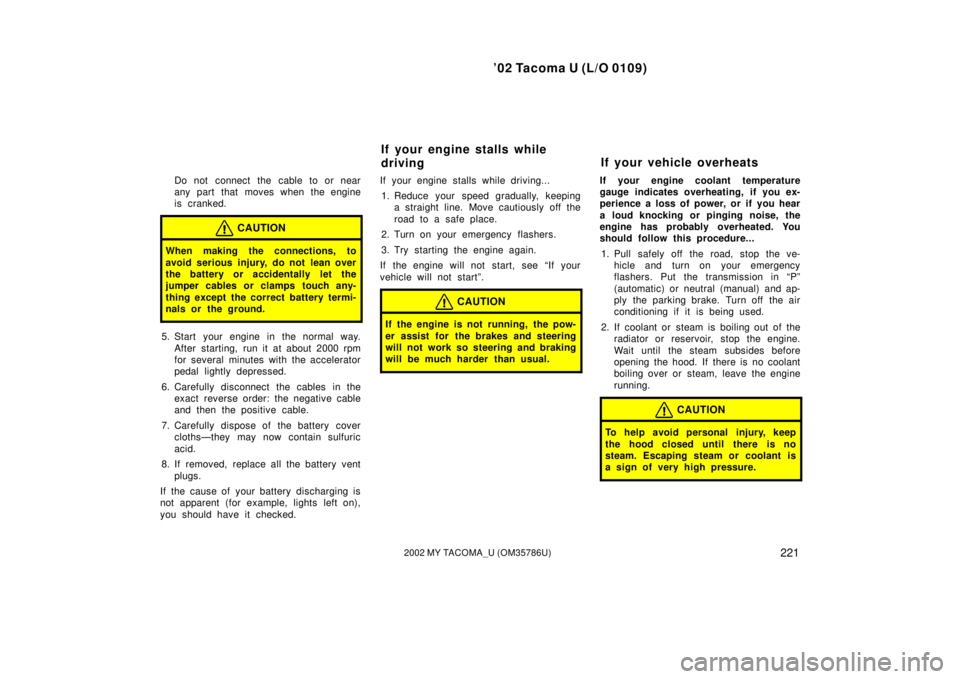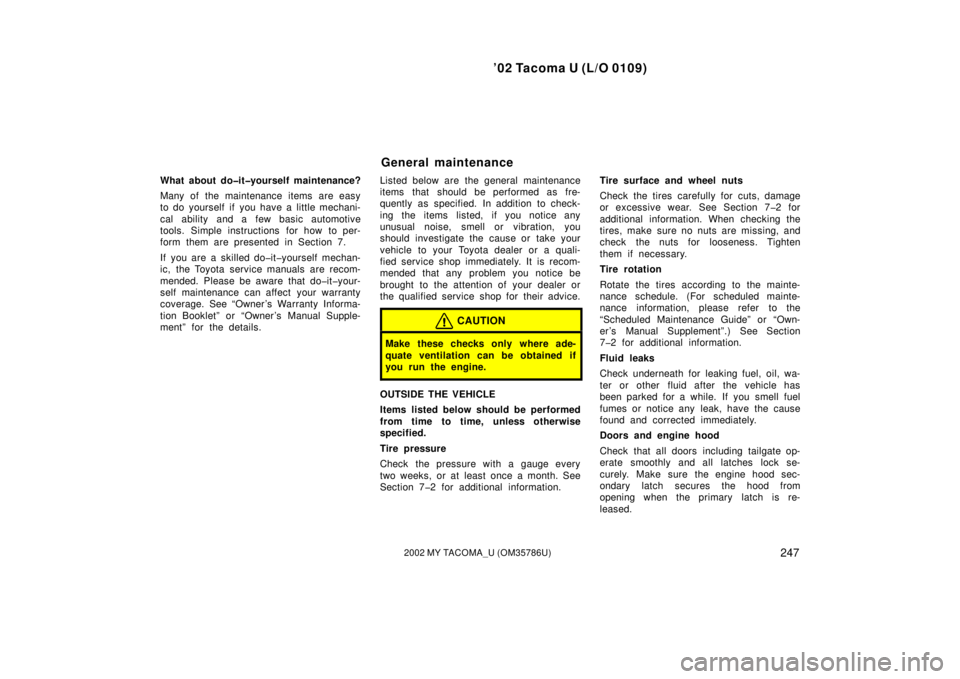Page 21 of 308
’02 Tacoma U (L/O 0109)
152002 MY TACOMA_U (OM35786U)
To open the tailgate, pull the handle up.
The support cables will hold the tailgate
horizontal.
See “Luggage stowage precautions” in
Section 2 for precautions in loading lug-
gage.
After closing the tailgate, try pulling it to-
ward you to make sure it is securely
locked.
NOTICE
Avoid driving with the tailgate open.
To lower the tailgate fully, release the
support brackets from the lugs as
shown.
NOTICE
�Lower the tailgate gently when it is
unhooked.
� Make sure the tailgate is securely
caught by the support brackets be-
fore closing the tailgate.
To open the hood:
1. Pull the hood lock release lever. The hood will spring up slightly.
CAUTION
Before driving, be sure that the hood
is securely closed and locked. Other-
wise, the hood may open unexpected-
ly while driving and an accident may
occur.
Tailgate Hood
Page 22 of 308
’02 Tacoma U (L/O 0109)
162002 MY TACOMA_U (OM35786U)
2. In front of the vehicle, pull up theauxiliary catch l ever and lift the
hood.
3. Hold the hood open by inserting the support rod into the slot.
Before closing the hood, check to see that
you have not forgotten any tools, rags,
etc. and return the support rod to its
clip—this prevents rattles. Then lower the
hood and make sure it locks into place.
If necessary, press down gently on the
front edge to lock it.
CAUTION
After inserting the support rod into
the slot, make sure the rod supports
the hood securely from falling down
on to your head or body.
With tachometer
Without tachometer
Fuel tank cap
Page 227 of 308

’02 Tacoma U (L/O 0109)
2212002 MY TACOMA_U (OM35786U)
Do not connect the cable to or near
any part that moves when the engine
is cranked.
CAUTION
When making the connections, to
avoid serious injury, do not lean over
the battery or accidentally let the
jumper cables or clamps touch any-
thing except the correct battery termi-
nals or the ground.
5. Start your engine in the normal way.After starting, run it at about 2000 rpm
for several minutes with the accelerator
pedal lightly depressed.
6. Carefully disconnect the cables in the exact reverse order: the negative cable
and then the positive cable.
7. Carefully dispose of the battery cover cloths—they may now contain sulfuric
acid.
8. If removed, replace all the battery vent plugs.
If the cause of your battery discharging is
not apparent (for example, lights left on),
you should have it checked. If your engine stalls while driving...
1. Reduce your speed gradually, keeping a straight line. Move cautiously off the
road to a safe place.
2. Turn on your emergency flashers.
3. Try starting the engine again.
If the engine will not start, see “If your
vehicle will not start”.
CAUTION
If the engine is not running, the pow-
er assist for the brakes and steering
will not work so steering and braking
will be much harder than usual.
If your engine coolant temperature
gauge indicates overheating, if you ex-
perience a loss of power, or if you hear
a loud knocking or pinging noise, the
engine has probably overheated. You
should follow this procedure...
1. Pull safely off the road, stop the ve- hicle and turn on your emergency
flashers. Put the transmission in “P”
(automatic) or neutral (manual) and ap-
ply the parking brake. Turn off the air
conditioning if it is being used.
2. If coolant or steam is boiling out of the radiator or reservoir, stop the engine.
Wait until the steam subsides before
opening the hood. If there is no coolant
boiling over or steam, leave the engine
running.
CAUTION
To help avoid personal injury, keep
the hood closed until there is no
steam. Escaping steam or coolant is
a sign of very high pressure.
If your engine stalls while
driving If your vehicle overheats
Page 253 of 308

’02 Tacoma U (L/O 0109)
2472002 MY TACOMA_U (OM35786U)
What about do�it�yourself maintenance?
Many of the maintenance items are easy
to do yourself if you have a little mechani-
cal ability and a few basic automotive
tools. Simple instructions for how to per-
form them are presented in Section 7.
If you are a skilled do�it�yourself mechan-
ic, the Toyota service manuals are recom-
mended. Please be aware that do�it�your-
self maintenance can affect your warranty
coverage. See “Owner ’s Warranty Informa-
tion Booklet” or “Owner ’s Manual Supple-
ment” for the details.Listed below are the general maintenance
items that should be performed as fre-
quently as specified. In addition to check-
ing the items listed, if you notice any
unusual noise, smell or vibration, you
should investigate the cause or take your
vehicle to your Toyota dealer or a quali-
fied service shop immediately. It is recom-
mended that any problem you notice be
brought to the attention of your dealer or
the qualified service shop for their advice.
CAUTION
Make these checks only where ade-
quate ventilation can be obtained if
you run the engine.
OUTSIDE THE VEHICLE
Items listed below should be performed
from time to time, unless otherwise
specified.
Tire pressure
Check the pressure with a gauge every
two weeks, or at least once a month. See
Section 7�2 for additional information.Tire surface and wheel nuts
Check the tires carefully for cuts, damage
or excessive wear. See Section 7�2 for
additional information. When checking the
tires, make sure no nuts are missing, and
check the nuts for looseness. Tighten
them if necessary.
Tire rotation
Rotate the tires according to the mainte-
nance schedule. (For scheduled mainte-
nance information, please refer to the
“Scheduled Maintenance Guide” or “Own-
er ’s Manual Supplement”.) See Section
7�2 for additional information.
Fluid leaks
Check underneath for leaking fuel, oil, wa-
ter or other fluid after the vehicle has
been parked for a while. If you smell fuel
fumes or notice any leak, have the cause
found and corrected immediately.
Doors and engine hood
Check that all doors including tailgate op-
erate smoothly and all latches lock se-
curely. Make sure the engine hood sec-
ondary latch secures the hood from
opening when the primary latch is re-
leased.
General maintenance
Page 283 of 308
’02 Tacoma U (L/O 0109)
2772002 MY TACOMA_U (OM35786U)
1. Open the hood. Unplug the connec-tor. Remove the rubber cover.
If the connector is tight, wiggle it.2. Release the bulb retaining spring and remove the bulb. Install a new
bulb and the bulb retaining spring.
To install a bulb, align the tabs of the
bulb with the cutouts of the mounting
hole.3. Install the rubber cover with the “TOP PULL” mark upward and
snuggle on the boss. Then plug in
the connector.
Make sure the rubber cover fits snugly on
the connector and the headlight body.
Aiming is not necessary after replacing
the bulb. When aiming adjustment is nec-
essary, contact your Toyota dealer.
—Headlights